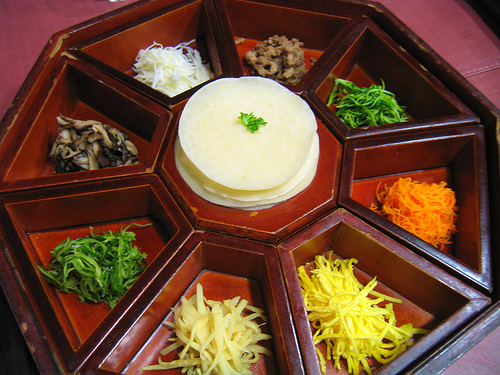- Gujeolpan
Infobox Korean name

hangul=구절판
hanja=linktext|九|節|坂
rr=gujeolpan
mr=kujŏlp'an"Gujeolpan" refers to either an elaborate Korean dish consisting of nine different foods assorted on a
wooden plate with nine divided sections in anoctagon shape or the plate itself. The name is comprised of threehanja words: "gu" (구, "nine" ), "jeol" (절, "section"), and "pan" (판, "plate") in Korean. Foods are separated by color and ingredients, and comprise various "namul " (seasonedleaf vegetable s), meats, mushrooms, and seafood items. In the center of the tray is a stack of small "jeon" (Korean stylepancake s) made withwheat flour , which are called "miljeonbyeong" (밀전병). In addition to its use as a food platter used to serve many dishes of food at once, "gujeolpan" is also considered a decorative item.cite news|url=http://english.chosun.com/english/contents/magazine/2001/Cuisine200101_1.html |publisher=Digital Chosun Ilbo / WHAT'S ON SEOUL|title=Korean Cuisine: For a beautiful plate and delicious food, try Gujeolpan |accessdate=2008-07-01] cite news|url=http://koreaconvention.org/enu/FU/FU_EN_15.jsp?cid=531398 |publisher=Korea Tourism Organization |title=Korea: Two Special Korean Dishes |accessdate=2008-07-01] cite web|url=http://100.empas.com/dicsearch/pentry.html?s=K&i=258311&v=43 |title=구절판 九節坂|publisher=Empas /EncyKorea |language=Korean]History and aesthetic appeal
The history of "gujeolpan" dates back as early as the 14th century in which it has become closely associated with the
Joseon royalty. The octagonal dish itself can be made of wood or plastic and its divided into eight side sections and one center section; slightly resembling a flower. It also can include elaborate carvings, gem encrustations and detailed drawings. Original royal "gujeolpan" dish platters can be observed in museums as featured artifacts in royal table setting reconstructions. "Gujeolpan" is considered to be one of the most beautiful and colorful centerpiece Korean dishes. The nine sections are carefully divided and assorted with an appropriate amount of assorted meats and vegetables to make it colorful and aesthetically appealing. It has even been said that authorPearl S. Buck was so amazed by the beauty and colorful appearance of "gujeolpan" that she could not stop praising it, and as a result, refused to eat it as she did not want to "destroy such a beautiful thing by eating it."Consumption
What was once available to Korean nobility can now be enjoyed by anyone in many places in Korea that specialize in preparing ancient Korean cuisine (though in some establishments it can be quite expensive). It is also sometimes prepared for wedding banquets. Each of the outer sections has different varieties of meat and vegetables, such as carrots, mushrooms, beef, bean sprouts, leeks, radishes, etc. while the center section is usually reserved for" miljeonbyeong", which are small circular, paper-thin wheat flatcakes similar, though smaller and softer than
tortilla s. [ [http://english.seoul.go.kr/today/about/about_02top_5801.htm Seoul Metropolitan Government - "A Clean, Attractive & Global City, Seoul!"] ] These are used to wrap the various meats and vegetables from each of the eight sections. "Gujeolpan" consumers pick and choose from the various eight sections, put them on a sheet of "miljeongbyeong", wrap it and eat it whole.ee also
*
Sinseollo
*Jeon
*Ssam
*Namul
*Korean royal court cuisine References
Wikimedia Foundation. 2010.
